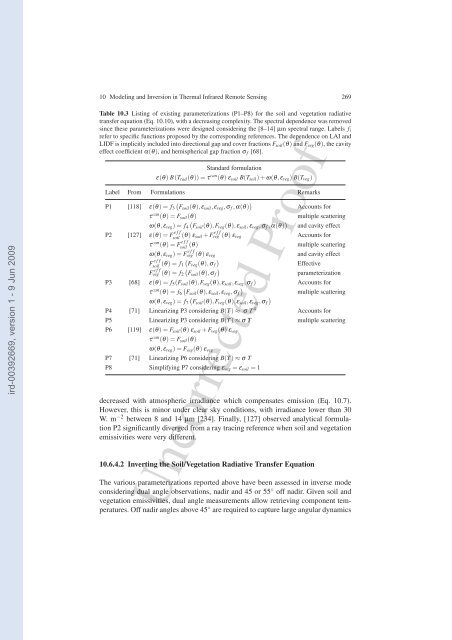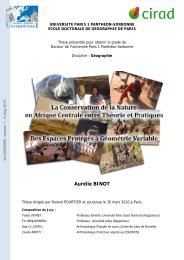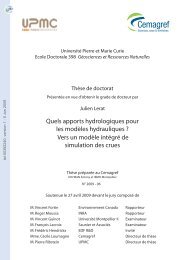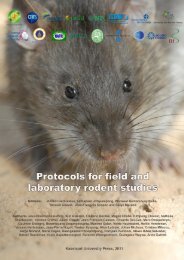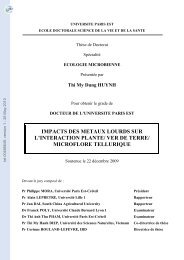Modeling and Inversion in Thermal Infrared Remote Sensing over ...
Modeling and Inversion in Thermal Infrared Remote Sensing over ...
Modeling and Inversion in Thermal Infrared Remote Sensing over ...
Create successful ePaper yourself
Turn your PDF publications into a flip-book with our unique Google optimized e-Paper software.
10 <strong>Model<strong>in</strong>g</strong> <strong>and</strong> <strong>Inversion</strong> <strong>in</strong> <strong>Thermal</strong> <strong>Infrared</strong> <strong>Remote</strong> Sens<strong>in</strong>g 269ird-00392669, version 1 - 9 Jun 2009Table 10.3 List<strong>in</strong>g of exist<strong>in</strong>g parameterizations (P1–P8) for the soil <strong>and</strong> vegetation radiativetransfer equation (Eq. 10.10), with a decreas<strong>in</strong>g complexity. The spectral dependence was removeds<strong>in</strong>ce these parameterizations were designed consider<strong>in</strong>g the [8–14] µm spectral range. Labels f irefer to specific functions proposed by the correspond<strong>in</strong>g references. The dependence on LAI <strong>and</strong>LIDF is implicitly <strong>in</strong>cluded <strong>in</strong>to directional gap <strong>and</strong> c<strong>over</strong> fractions F soil (θ) <strong>and</strong> F veg (θ), the cavityeffect coefficient α(θ), <strong>and</strong> hemispherical gap fraction σ f [68].St<strong>and</strong>ard formulationε(θ) B(T rad (θ)) = τ can (θ) ε soil B(T soil )+ω(θ,ε veg ) B(T veg )Label From Formulations RemarksP1 [118] ε(θ)= f 3(Fsoil (θ),ε soil ,ε veg ,σ f ,α(θ) ) Accounts forτ can (θ)=F soil (θ)(ω(θ,ε veg )= f 4 Fsoil (θ),F veg (θ),ε soil ,ε veg ,σ f ,α(θ) )P2 [127] ε(θ)=F ef fsoil (θ) ε soil + Fveg ef f (θ) ε vegτ can (θ)=F ef fsoil (θ)multiple scatter<strong>in</strong>g<strong>and</strong> cavity effectAccounts formultiple scatter<strong>in</strong>gω(θ,ε veg )=Fveg ef f (θ) ε veg<strong>and</strong> cavity effectF ef fsoil (θ)= f ( )1 Fveg (θ),σ f EffectiveFveg ef f ( )(θ)= f 2 Fsoil (θ),σ f parameterizationP3 [68] ε(θ)= f 5 (F soil (θ),F veg (θ),ε soil ,ε veg ,σ f ) Accounts forτ can ( )(θ)= f 6 Fsoil (θ),ε soil ,ε veg ,σ f multiple scatter<strong>in</strong>g( )ω(θ,ε veg )= f 7 Fsoil (θ),F veg (θ),ε soil ,ε veg ,σ fP4 [71] L<strong>in</strong>eariz<strong>in</strong>g P3 consider<strong>in</strong>g B(T ) ≈ σ T 4 Accounts forP5 L<strong>in</strong>eariz<strong>in</strong>g P3 consider<strong>in</strong>g B(T ) ≈ σ T multiple scatter<strong>in</strong>gP6 [119] ε(θ)=F soil (θ) ε soil + F veg (θ) ε vegτ can (θ)=F soil (θ)ω(θ,ε veg )=F veg (θ) ε vegP7 [71] L<strong>in</strong>eariz<strong>in</strong>g P6 consider<strong>in</strong>g B(T ) ≈ σ TP8 Simplify<strong>in</strong>g P7 consider<strong>in</strong>g ε veg = ε soil = 1decreased with atmospheric irradiance which compensates emission (Eq. 10.7).However, this is m<strong>in</strong>or under clear sky conditions, with irradiance lower than 30W. m −2 between 8 <strong>and</strong> 14 µm [234]. F<strong>in</strong>ally, [127] observed analytical formulationP2 significantly diverged from a ray trac<strong>in</strong>g reference when soil <strong>and</strong> vegetationemissivities were very different.10.6.4.2 Invert<strong>in</strong>g the Soil/Vegetation Radiative Transfer EquationThe various parameterizations reported above have been assessed <strong>in</strong> <strong>in</strong>verse modeconsider<strong>in</strong>g dual angle observations, nadir <strong>and</strong> 45 or 55 ◦ off nadir. Given soil <strong>and</strong>vegetation emissivities, dual angle measurements allow retriev<strong>in</strong>g component temperatures.Off nadir angles above 45 ◦ are required to capture large angular dynamicsUncorrected Proof


